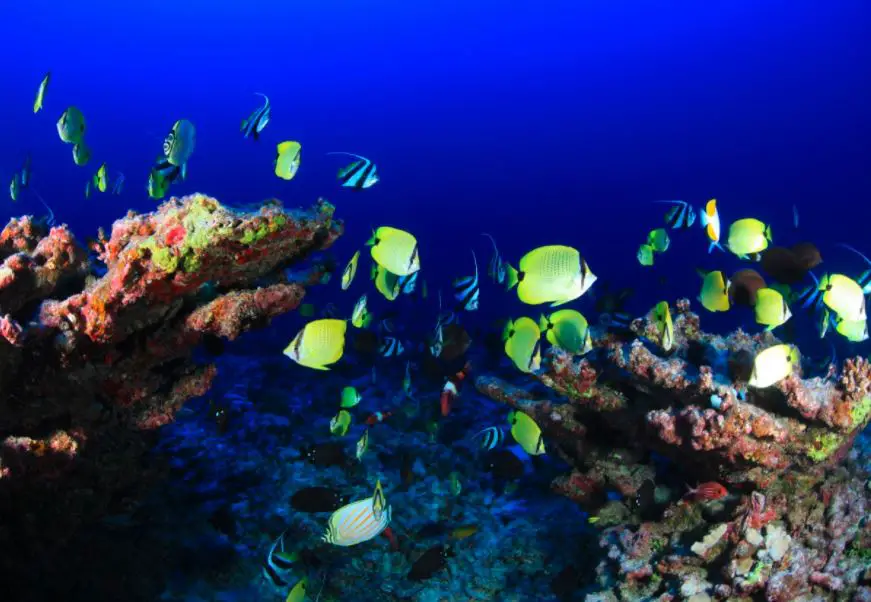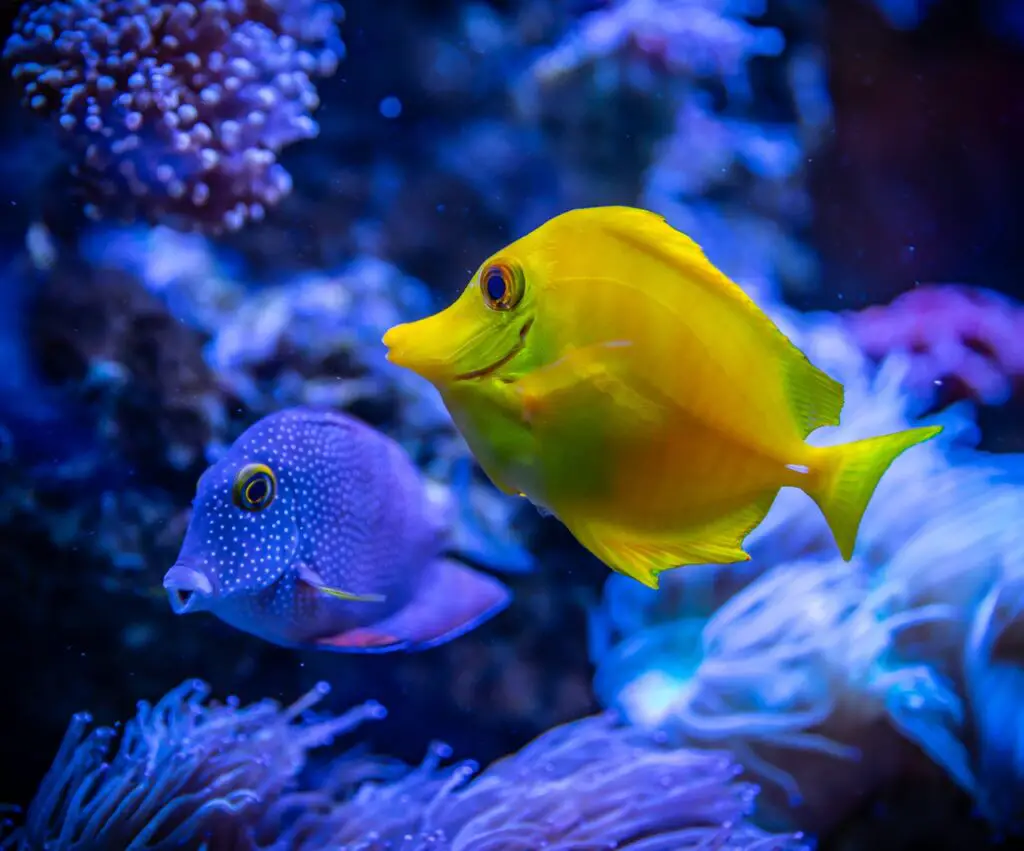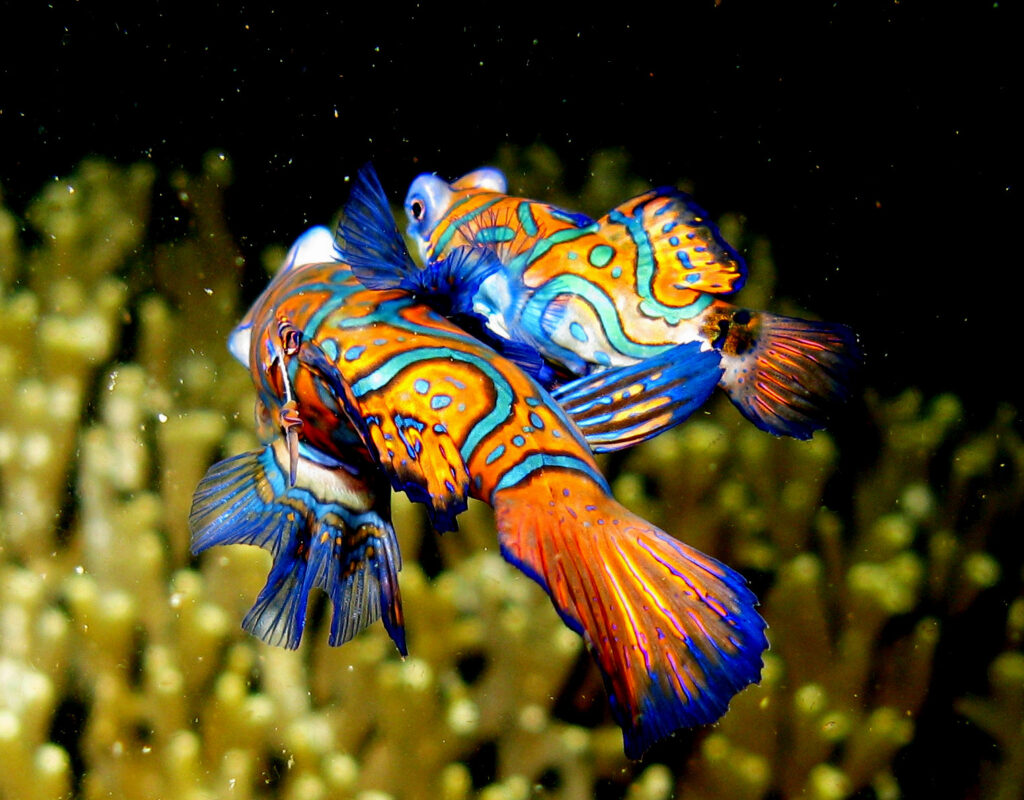Are you setting up a saltwater aquarium for the first time? Naturally, you’re probably thinking about the brilliant fish and critters you can introduce into your tank. There are plenty of vibrant looking species out there, which means that you are going to find plenty of vivid species that are fascinating to watch.
But which fish really do offer the best saltwater experience? Which are easy to look after? Which are best for smaller tanks? In this guide, we’ll be taking a look at what we think are the 19 coolest saltwater aquarium fish available for you to adopt and introduce into your home tank.
Do make sure to read our other guides on saltwater tanks and aquariums, too, if it’s your first time owning or breeding any of the following fish.
Blue Devil Damselfish (Chrysiptera cyan)

Let’s start with this fascinating saltwater critter. Sometimes referred to as the orange tail damselfish, blue devil damselfish are some of the most popular home tank fish worldwide. They are very small and tend to be fairly common. They’ll grow to be about three inches long, which means you should be able to host a few in a large enough tank! They tend to be great for beginners, too.
As you can imagine, these fish tend to arrive with a shocking blue tint, making them some of the most striking swimmers in any saltwater tank regardless of their tiny size. These are really cool fish to introduce to your tank if you’re looking for an aquatic pet to stay with you for three or four years. Be warned, some blue devil damselfish can be quite territorial and aggressive. They’re very brash and bold, which means if you’re looking for a peaceful tank, it’s best to look for something a little more placid!
Domino Damselfish (Dascyllus trimaculatus)

Otherwise known as the three spot domino damselfish, this odd-looking critter is so-named because – well – it looks like a floating domino! Bigger than their blue devil cousins, this striking swimmer will grow to be around five and a half inches in size, meaning a fairly big tank is an absolute must if you want to host a few. They tend to be pretty easy to look after and will eat pretty much anything you put in front of it.
However, like the blue devils, these damselfish tend to get a bit aggressive when paired with some other fish, so make sure that you carefully temper your community tank. These fish tend to get more aggressive as they get older – that might make it sound as if they’re not pleasant to have in your tank, but they are really rewarding.
Just be ready to host a tank that’s high on the drama – and this fish loves eating meaty food, meaning it’s well worth stocking up on the live bait!
Three Stripe Damselfish (Dascyllus aruanus)
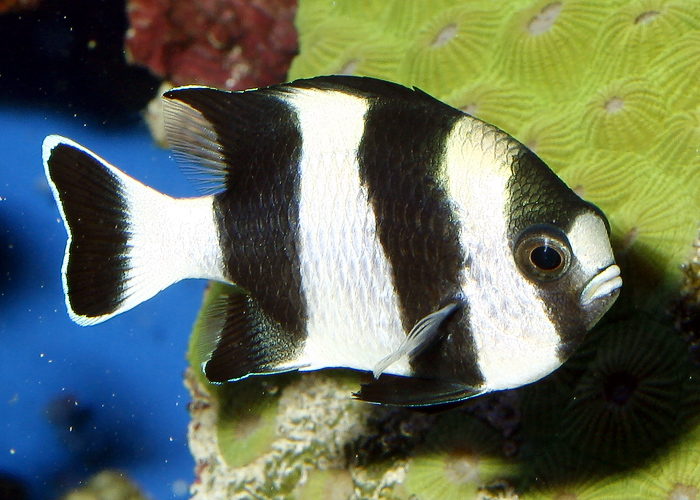
This super-popular damselfish has a striped look to its body and is easy to spot! These fish tend to grow to be around four inches long, maximum, and like the two damselfish listed above, they will eat pretty much everything. They like having places in the tank to duck and dive in and out of, so make sure that you have hiding spots available in a fairly large tank.
Again, as with other damselfish, the three stripe can get more aggressive and bolder as it gets older. However, it’s not a complete bully – it will do really well in a tank environment alongside fish of a similar nature, meaning other damselfish might be a good spot. Otherwise, there’s not much need to worry about these fish – they don’t tend to be that disruptive.
You’d normally find these saltwater beauties in the watery wilds of Indonesia, meaning they really are tropical – and as you’d expect, they like their water to be pretty warm. They’re really easy to look after, otherwise.
Common Clownfish/Percula Clownfish (Amphiprion ocellaris/percula)

If there’s any saltwater fish that just about everyone under the age of 40 will recognise, it’s the common clownfish. That’s thanks to a certain Disney Pixar movie from a few years ago! The clownfish, or at least the ‘false percula’ species, tends to be a really popular choice for saltwater tanks. These are ‘false perculas’ because actual perculas are a completely different species. However, it’s not always so easy to tell them apart! The common clownfish will have different banding compared to the real percula fish. They are also close relations.
Common clownfish on the whole will grow to be around four inches in size, though some will mature smaller. They tend to be pretty hardy, and as you can imagine, they are a joy to watch. You’ll need a fairly big tank if you want to bring several together, but that’s to be expected. You’ll normally find Nemo and friends out in the Indian and Pacific Oceans.
They really are odd little fish in that they seem to have pretty unique swimming styles and patterns. Again, keep in mind that clownfish and perculas can be aggressive at times, meaning it’s worth keeping them away from anything particularly timid. Otherwise, they are super easy to care for. We love them!
Yellowtail Damselfish (Chrysiptera parasema)
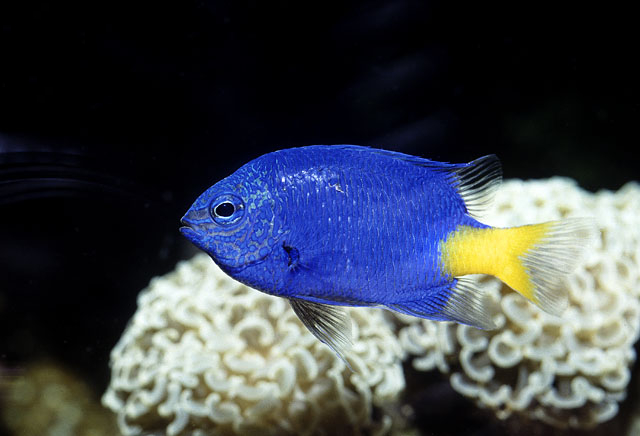
Wow – this damselfish really does need to be seen to be believed! This shocking blue and yellow beast, complete with striking spines, is likely to be one of the stand-outs in any saltwater tank. In fact, it’s likely you’ll see them in plenty of hobbyist tanks. They are not only gorgeous to look at, but they are also really simple to care for. They grow to be just short of three inches long, max, and you will normally find them out in the Pacific.
Like other damselfish, the yellowtail can be aggressive, but is actually fairly laid-back compared to its cousins listed above. What’s more, they don’t tend to rely on needing as much space. Therefore, if you’re keen to find a damselfish for your tank but want to keep it small and peaceful, yellowtails are likely to be the best picks for you.
These fish love eating algae, which is great news if you are struggling to keep levels low. These fish can be hard to breed as it’s not always easy to tell their genders. They love small groups and will do well in beginner tanks.
Four Stripe Damselfish (Dasyllus manures)

Adding an extra stripe on the damselfish we examined earlier, these gorgeous fish are in fact pretty similar. They tend to be the same colour – black and white – and also tend to have the same temperament. However, as explained, that doesn’t make them bad pets! These damselfish are really rewarding providing you care for them well, and providing that you keep them from being aggressive in your tank. The best thing to do is to introduce them to a tank with fish of a similar attitude!
Four stripe damselfish can be fairly common, and unless you actually count the stripes, the casual eye may not be able to tell these and their three stripe cousins apart! However, they will both give you a wonderful starter fish experience for your saltwater aquarium, so be sure to take a look at adopting a couple for your larger tank.
Again, like other damselfish we’ve seen so far, the four stripes are omnivores, and will need a mix of different types of food to keep healthy.
Azure Damselfish (Chrisptera hemicyanea)

If you can’t already tell, we love damselfish! This particular species is really striking – spiky, small and full of attitude, they are great for less placid tanks, and arrive in colourful blues and yellows. The azure damselfish won’t bother you too much for space, with these critters generally growing to be around three inches in size, maximum. They tend to hail from around the Indonesian side of the Pacific, and yes, again, they will pretty much eat anything – so make sure you give them a balanced diet.
The azure damselfish is very easy to care for on the whole, but as mentioned, they have a little bit of an attitude, which means you should try to pair them up with critters with the same aggression levels. Other damselfish, for example, might be a good start.
Azure damselfish tend to enjoy setting up their own territories, which means it is well worth cordoning off parts of your tank with hiding spots. Providing other fish don’t disturb them in their hiding zones, there are no reason why you won’t get on with these creatures!
Firefish (Nemateleotris magnifica)

Otherwise known as the magnificent dartfish – a brilliant name – these plucky, active fish will add more than a little colour to your saltwater tank.
Amazingly acrobatic and a lot of fun to watch, firefish are also great choices if you are just getting started with your own saltwater tank for the first time. Some may see these critters as fairly ornamental, but these are gobies which do more than just sit around looking pretty.
They flap around the tank, seemingly full of energy – they are great for tanks with personality and style.
Despite their high energy presentation, firefish are actually very peaceful. In fact, they can feel threatened easily, meaning you should always make sure to match them up with less aggressive fish in the same tank.
For example, they probably won’t do too well alongside some of the feistier damselfish listed above!
These fish love warm waters and will tend to swim well in water towards the more alkaline end of the pH scale.
As with other saltwater fish we’ve looked at so far, the firefish will generally eat much of what you put in front of it, so give it some meaty bait as well as plenty of vegetation, too.
Banggai Cardinalfish (Pterapogon kauderni)
The Banggai cardinalfish really is a special type of beast. Slightly terrifying looking thanks to its enormous eyes and long tendrils, this is actually a really placid and pleasant fish to host in saltwater tank!
They tend to prey on microlife, meaning that you can expect to feed them easily on plankton. They tend to enjoy bigger tanks, particularly as the younger specimens will need spaces to hide. They can be somewhat timid.
These creatures really are a great find if you can adopt them, as they seem to only ever come from the Banggai archipelago. However, we would advise that you take care as they are, at the time of writing, on the IUCN’s endangered red list. However, these are fish that really do reproduce quickly.
While great to look at and genuinely rewarding if you have a big enough saltwater reef tank, you may want to look for a different type of saltwater critter if you’re worried about contributing to their endangered status.
Don’t worry, there are plenty of other non-protected species on this list that you can feel less guilty about bringing home into your own saltwater reef.
However – just take a look at the Banggai cardinalfish – it really is an eye-popping creature, and there’s little wonder so many saltwater fish fanatics enjoy them.
Mandarinfish (Synchiropus splendidus)
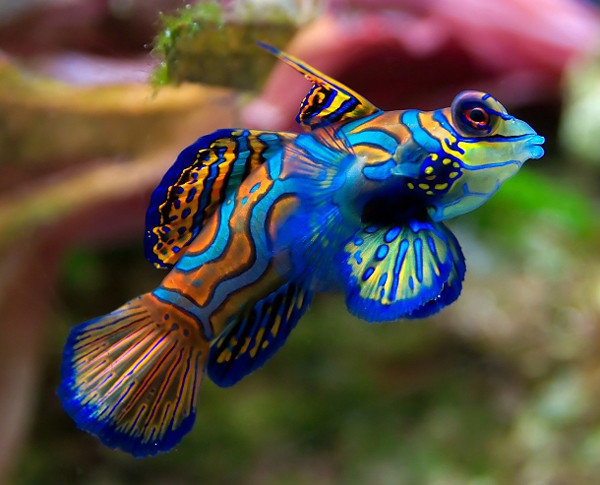
The mandarinfish is perhaps one of the most bizarre-looking saltwater fish on our list, and that’s part of what it makes it really cool.
They tend to be quite tricky to look after, however, meaning that they are likely to be a good tank spot for you if you’ve been keeping saltwater creatures for a while. They tend to need bigger tanks, meaning at least 75 gallons will be ideal to keep on the safe side.
These multicolour, psychedelic fish are actually really laid-back. They tend to be pretty active during the day, which means it’s not unheard of for you to see a mandarinfish or two darting about.
They also tend to be pretty hardy, meaning they shouldn’t fall victim to many of the diseases and conditions that other saltwater creatures are known to struggle with. It’s fairly easy for you to tell the difference between males and females thanks to their spines.
These fish love live food and are actually known in the fishkeeping hobby as grazers. This means that they are constantly on the hunt for live critters to munch, and naturally, that means you should probably keep smaller beasts away from them at all times.
The mandarinfish might take a little bit of time to get fully confident in your tank, but providing you have plenty of space and lots of rock and reef, they’ll soon swim out and enjoy themselves.
Blue Hippo Tang (Paracanthurus hepatus)
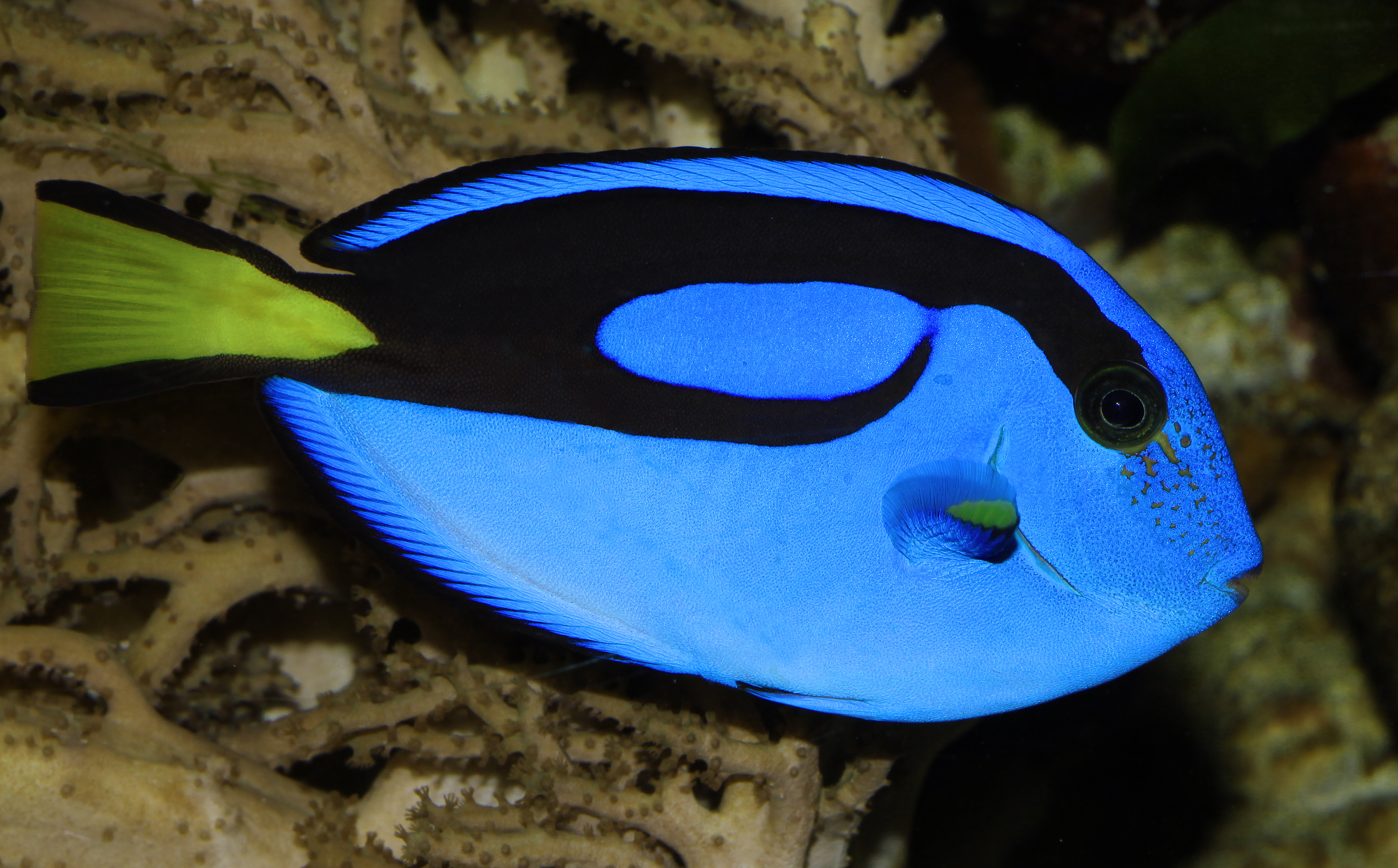
Much like the common clownfish listed above, Disney and Pixar have a lot to answer for when it comes to the popularity of the blue tang!
The blue hippo tang actually has lots of different names, such as the Pacific blue tang and the flagtail surgeonfish. Therefore, if you’ve seen these creatures before under a few odd names, they are more or less the same beasts.
Blue tangs are amazing to watch as they are incredibly active. However, they can grow to be pretty huge – up to six inches in length – which is surprising given that they grow up from around one inch in length as youngsters!
Therefore, a big tank really is a must. By big, we might even mean as large as 180 gallons! Seriously, blue tangs love being able to dart about, and as they can grow to be pretty massive on the relative scale, it’s worth giving them room to stretch their fins.
Blue tangs tend to be pretty placid on the whole, even slightly dopey – but they can get very territorial with one another. Some, sadly enough, will fight to the death. Therefore, it’s worth making sure you keep them with fish of a similar size and temperament – but just not too many other tangs!
These fish can be easy to look after but will generally need TLC thanks to their disease prone nature. They are otherwise really adorable!
Bluestreak Cleaner Wrasse (Labroides dimidiatrus)
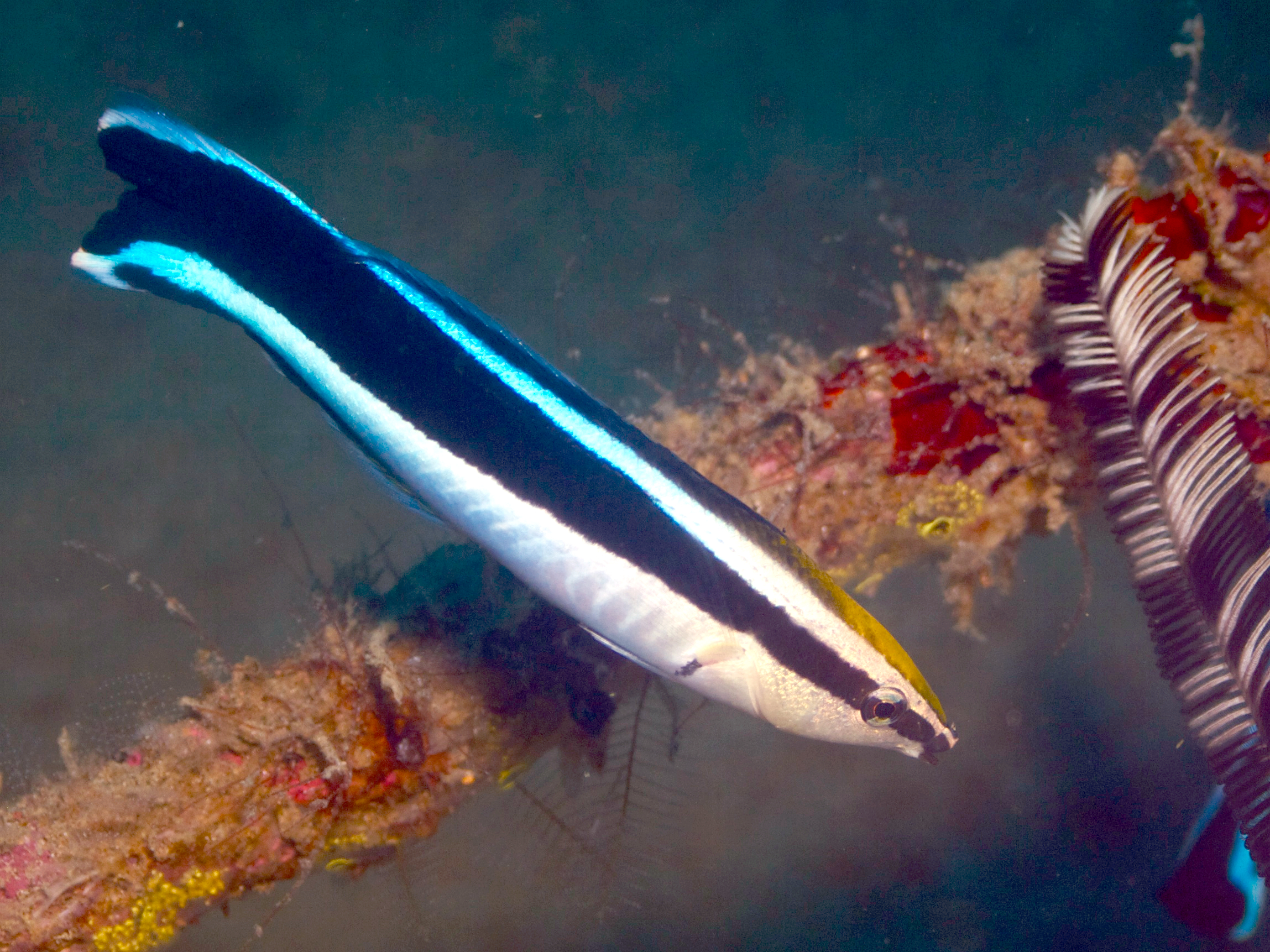
These sleek reef-loving wonders tend to be a little rarer than some of the others in our lists, and they are really interesting as they can choose to go it alone or couple up.
You might even find some of these super active fish in small groups. Long and thin, these black and white fish can grow as long as five and a half inches. You’ll spot them thanks to their blue streak markings, too, hence their names.
While these fish are exciting to watch and make really rewarding pets, they can take a lot of care. Thanks to their potential size as well as their habits of speeding about at breakneck speed, you are going to need to give them plenty of space.
That’s going to mean a fairly big tank. They will do best in tanks with lots of fish that are shaped differently to themselves. What’s more, you’re going to need to keep a safe enclosure on these fish, as they can have a habit of leaping!
We’d normally recommend the bluestreak cleaner wrasse to a saltwater fish keeper with a few years of experience. Not as easy to leave on their own as damselfish or clownfish, these creatures need a careful watch as well as a careful carnivorous diet. Maybe this is one fish you can work your way up to!
Flame Angelfish (Centropyge loricula)

A great-looking fish that’s sure to add a little orange tinge to any tank, this is an angelfish that tends to be a good pick for anyone with a few years of experience with saltwater fish in general.
Not as tricky as the bluestreak wrasse, this lovely addition will grow to be around four inches in length and will hoover up any food you put in front of it. Like damselfish, they are omnivores, but tend to do well on diets of algae and spirulina, as well as shrimp.
The flame angelfish can be a little tricky to manage as a beginner as it’s very sensitive to some water conditions. Therefore, you need to make sure there is a low level of copper in the tank.
Flame angelfish can adapt well to various community tanks, but you will tend to get the best out of them if you place them in your tank as the final addition.
What’s really strange about the flame angelfish is the fact that there is next to no physical indicators as to which are male, and which are female. This can make them a bit of a sticking point of saltwater breeders.
They love live rock formations, and as a result of their placid to slightly aggressive natures, you should always make sure you have plenty of hiding places for them.
Maroon Clownfish (Premnas biaculeatus)

Yes – there are many, many different types of clownfish! This particular species is really striking in that it’s brown in colour and has bright yellow stripes. It’s certainly easy for you to tell these swimmers apart from the rest in any given tank.
It’s regarded as a fairly aggressive or territorial clownfish on the whole, meaning that it’s seen as something of the bully in the set. In fact, it is never a good idea to try and put them in with other clownfish species.
You’ll generally do best keeping this fish in its own tank or in pairs – seriously, it can get that bold or brash if you give it plenty of opportunity! However, this doesn’t stop them being a great-looking fish and a really rewarding addition to any saltwater tank. They also grow to be very big compared to other clownfish, reaching almost six and a half inches at max size.
As you can imagine, this fish is tropical and therefore loves warmer water temperatures. They tend to do really well in reef environments – they just don’t play well with others! As with other clownfish, however, they are hermaphroditic, which means they are born male – before one in the school decides to turn female! Females tend to be larger than males in this species, making them easy to spot.
Coral Beauty (Centropyge bispinosa)
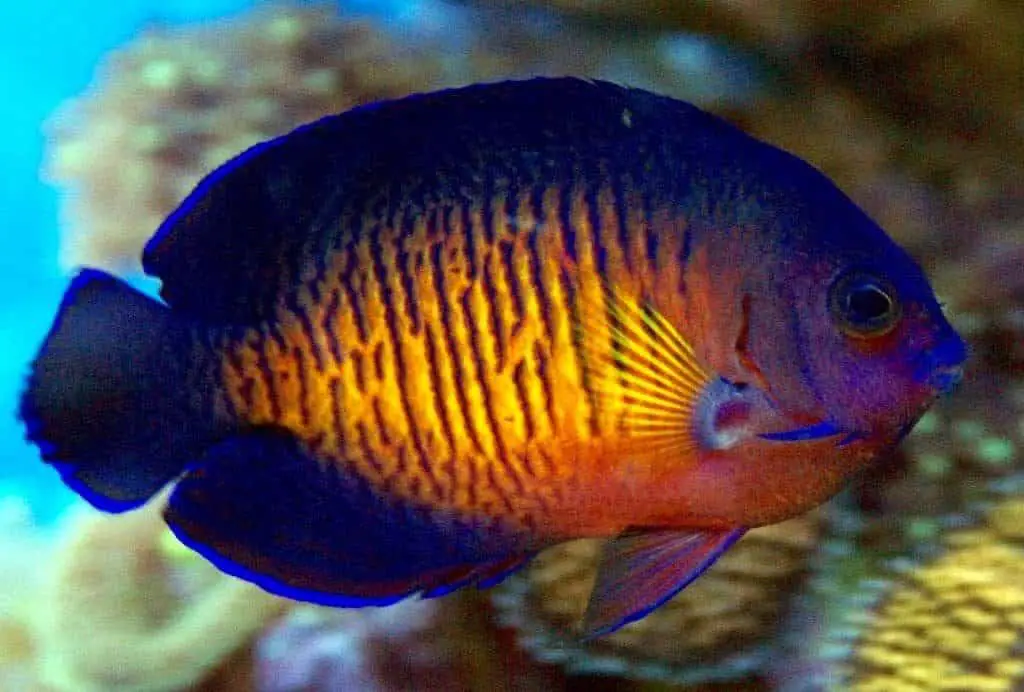
The coral beauty is an angelfish that really does brighten up any tank. It’s actually a dwarf type of angelfish, which makes it smaller than most, but that doesn’t mean it’s worth ignoring. This is also known as the two-spined angelfish, and you can normally find them in shocking shades of blue, orange and yellow. You may well have seen a few floating around in tropical tanks before!
These are reef fish. In fact, coral beauties come from the Great Barrier Reef! They tend to be fairly placid but are known to be aggressive from time to time, meaning it’s worth being careful if you want to give them any tank mates. They can grow up to four inches in size, but you can find coral beauties as small as an inch long. Obviously, the bigger the tank the better.
Coral beauties are really easy to look after on the whole, and love to hide. They tend to eat everything, but it’s worth serving shrimp to them every once in a while for a bit of meat.
Six-line Wrasse (Pseudocheilinus hexataenia)
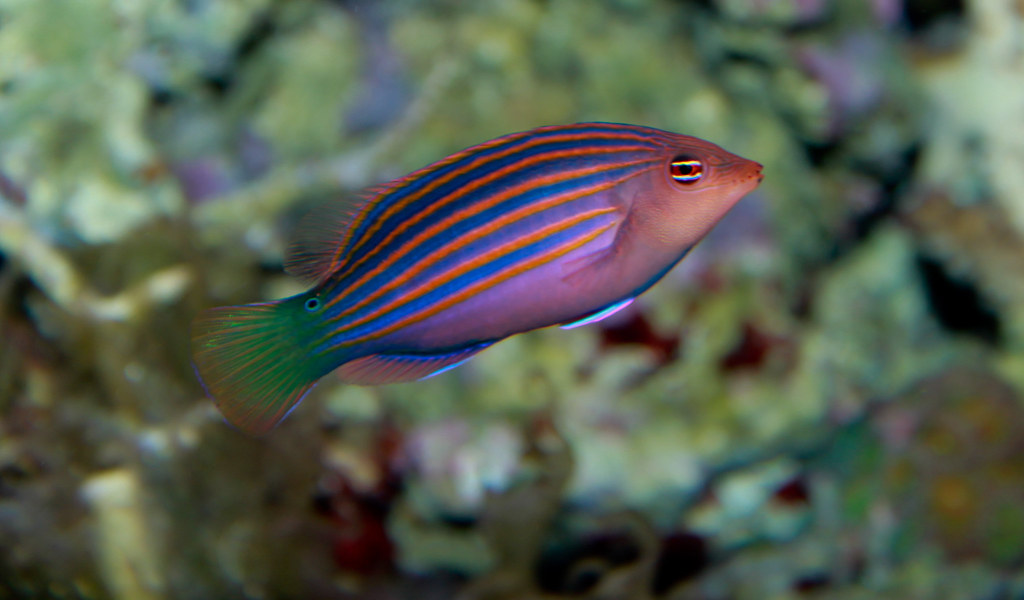
The six-line wrasse is a fish that seems to have gotten fashion tips from the 80s and 90s – it’s a really retro-looking creature that can add a lot of colour and charm to a tank, and as they tend to be fairly hyperactive, owners will normally see flashes of colour darting around in a six-line wrasse tank. They tend to grow to be no more than three inches long, but thanks to their sheer speed and activity, it’s normally a good idea to look for a tank that’s larger than what you normally expect.
These wrasses can be a little aggressive sometimes, but you can counter-act this by making sure there are plenty of hidden areas and hiding spots. You’ll also need to feed them on live food, as they won’t touch any vegetation – they are pure carnivore! These fish tend to be found in all kinds of locations in the wild, from the Maldives and Fiji out towards Kenya.
A six-line wrasse is likely to get on fine in quieter tanks, meaning you should probably avoid putting them in communities with anything more than a little aggressive. However, it’s also worth noting that six-line wrasses won’t get on with other wrasse species who tend to be shy and retiring. That is, unless it has plenty of spots it can hide.
These fish are some of the coolest for your tank thanks to their colours and their activity levels. They are really rewarding!
Tomato Clownfish (Amphiprion frenatus)

Sometimes just called the red clownfish, this variant on the species is, oddly enough, a shade of orangey red. They can grow to be five inches in length, making them some of the biggest clownfish around, though you will often see them grow to be much smaller. That said, a bigger tank is likely to be a good idea.
These clownfish tend to be some of the hardiest, which means beginner saltwater fish keepers will do well with them – they can be left to persist on their own providing you feed them well and keep them in the best environment. They tend to be really easy to breed, too, which means if you want more of them, they are a good starting point for the novice breeder.
Though a little aggressive at times, the tomato clownfish is a very rewarding saltwater critter and will eat pretty much anything. However, it’s a good idea to treat it to meat and plants in equal measure.
Royal Gramma (Gramma loreto)

The royal gramma, sometimes called the fairy basslet, tends to be a great entry level fish for many reasons. However, it’s so much more than an easy fish to look after! It’s got lots of bright colours and tends to be one of the smaller, more sprightly fish you’re likely to put in your saltwater tank. They tend to need very little looking after and can be some of the longest-living varieties you’ll host in your tank. They love reef tanks, too, so stock up on coral!
These fish can grow up to three inches in length, which means a medium to large tank is probably a good choice if you want to adopt several of them in one go. They also have lovely temperaments, which means they shouldn’t really cause you any problems. Of course, you should make sure that you keep these placid creatures away from anything slightly more aggressive, and anything larger.
These yellow and purple fish are great for beginner saltwater tanks that have lots of plants. Royal grammas love having somewhere to hide, so make sure you furnish their tanks accordingly.
Pajama Cardinalfish (Sphaeramia nematoptera)

Last and definitely not least, the pajama cardinalfish is a striking sea critter that, much like other cardinalfish in this list are well known for their larger than normal eyes! Tending to hail from Indonesia as well as the waters of Fiji and Sri Lanka, these greenish-coloured swimmers can grow to be three and a half inches in length but may often be much smaller. They like their water to be on the upper end of the acidity scale.
They are really easy to spot – literally – thanks to their polka dot patterns. They tend to do fairly well in small schools, and they are some of the most laid-back fish you should hope to introduce to a saltwater community. However, they do tend to like hiding and camouflaging a lot and tend to be quite slow-moving. Therefore, they are unlikely to be as sprightly as some of the more active fish listed earlier on in our guide.
They are carnivores, so live bait, naturally, is going to be an absolute must for these fish. Otherwise, they are extremely easy to look after!
Are Saltwater Fish Easy to Look After?
That all depends on the type of fish you choose – many, such as clownfish and damselfish species, tend to be some of the hardiest and most comfortable to persist on their own. Others will need special care – such as those which are likely to be sensitive to certain water conditions.
Saltwater or reef fish in this list all tend to enjoy warmer water as well as specific pH. Some of the creatures we list here prefer more alkaline water, meaning anything higher than 8.0 on the scale is likely to be a winning combination. However, you must make sure to check what specific species like the best.
It’s easy to assume that all fish are likely to get on with one another, Unfortunately, there is still going to be a food chain and competition in any tank environment, which means you should ideally look to match up your fish in terms of temperament as well as in terms of water temperature and conditions such as pH.
It’s a balance that might not seem easy to arrange at first, but once you really start getting into fishkeeping, it might surprise you as to how easily setting up perfect tankmates comes to you.
What Size of Saltwater Tank is Best for My Fish?
You should look for a tank that give at least two gallons of space for every inch of fish.
Therefore, if you have three fish at two inches each, you will need a tank that is at least 12 gallons. As this is a non-standard volume for fish tanks and aquariums, it’s probably better to err on the side of caution and to look for a bigger tank, rather than to scale down and go even smaller. For example, higher than 12 gallons, 20 gallons is likely to be a safe point to purchase.
Space is really important for fish. The more active swimmers are going to need lots of space to dart about in. The shyer or more territorial fish are going to need big spaces with rocks and spots where they can hide away if they need to. Even some of the more aggressive fish out there simply want time alone – and if you give your fish enough space for all your species to set up their own private homes, you shouldn’t have an issue.
We’d normally only recommend small tanks if you are just getting started with saltwater fish, or if you only have your eyes on one or two species at any one time. There are tanks in nano sizes, for example, which are great for very small species as well as for single or coupled fish. However, there’s the argument that nano tanks are actually only going to be ideal for experienced fish owners – particularly as you’re going to need to keep a closer eye on it.
Yes – a smaller tank is easier to clean and you need to make less space for it, but you really need to think about your fish. A cramped or smaller space than the average isn’t going to be much fun for them. Think about how much space you need in your everyday life!
What Makes a Cool Saltwater Aquarium Fish?
As you can see from our list above, there are plenty of wild and wonderful species out there which are great fun to look after. It’s not always the case that the best fish are those which are easy to care for, as there are plenty of intensive care species which are incredibly fun to watch over time.
First of all, think about colour. One of the first things tropical fish keepers look for is colour, and it’s not hard to see why. Some fish come in vivid yellows and purples, while others are striped, flecked or otherwise. A colourful fish is going to look wonderful in any tank – especially when you add a piece of coral or two into the mix.
You should also think about activity levels! The quieter and slower-moving fish are lots of fun to look after, but many people who own saltwater tanks will also want to look for creatures that swim about and offer tons of personality. Some, like wrasses, have stacks of energy and never seem to stop!
However, these fish can take a little bit of extra care to look after simply because they require a bit more space to be able to stretch their fins, and what’s more, there are some fish which can leap out of the water! Beginners may therefore want to think about looking after the calmer, slower-moving species out there first.
Of course, you should also think about looking at fish which aren’t your everyday species. It’s a good idea to keep a sense of conscience and to avoid adopting anything that’s considered endangered or on a red list. However, there are still plenty of Indo-Pacific species out there which will really change the look of your tank!
Ultimately, a cool fish is one that appeals to you. There are certainly no rules – and if you have a few years of fishkeeping behind you, then it’s worth looking for critters with temperaments you can handle.
Where Do I Get Started with a Saltwater Tank?
Make sure to read our full guides on how to set up and look after saltwater fish if you are completely new to the world of tropical fishkeeping – as it can require a lot of preparation! For one thing, you may need to let your water go through the nitrogen cycle before you can safely introduce any fish or plants.
Find yourself a good size of tank that you have room for, and a pump that you can use to help keep the water clean and healthy for species to swim and live in. You should also take your time to look through the different species we’ve listed above, and to do some further reading!
Saltwater fish can be really exciting to look after. Getting the perfect tank setup isn’t an exact science, so don’t worry if you need a bit of time to adjust! Again – we’re here to help, so make sure you check out our other guides and regular pieces.
SOUIRCES

